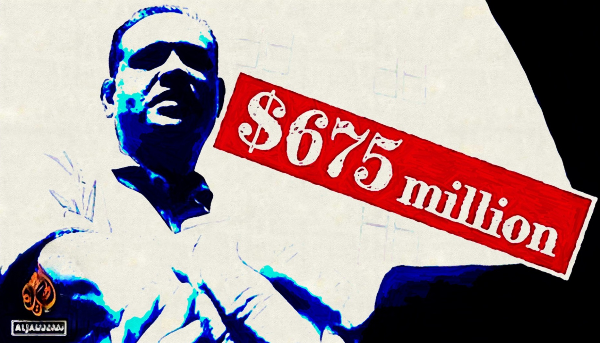Why Saifuzzaman's real estate empire evokes greater anger and imagination about corruption than others for the average Bangladeshi?

By now, the Al Jazeera Investigative Unit’s latest documentary, “The Minister’s Million,” has likely been viewed by tens of millions in Bangladesh and around the globe.
This investigation uncovered properties worth over 8,000 crore taka owned by former land minister Saifuzzaman Chowdhury, with a significant portion located in London, in where he resides in a lavish five-floor property valued at at least 180 crore taka, complete with a private theater and beautifully landscaped garden in one of the city’s most affluent neighborhoods.
Conducted over three years through a sting operation, this investigation, as explained by Zulkernain Saer from the AJI unit, has been condensed into a gripping 27-minute documentary.
It features a captivating narrative similar to Al Jazeera’s acclaimed investigative film on Bangladesh, “All the Prime Minister’s Men,” which also involved Saer in its undercover efforts.
A well-crafted visual investigative documentary best captures the audience's attention, leaving little to the imagination while providing just enough context for viewers to piece together the story of even bigger untold or undiscovered corruption at play.
In the documentary, the undercover reporter met with a group that included lawyers and bankers, subtly hinting at how illicit funds can be funneled into offshore properties through a well-connected network of money launderers.
According to data analysis from the US-based research institute Global Financial Integrity (GFI), approximately $149.20 billion or 17 lakh 60 thousand crores taka has been illicitly taken out of the country during Sheikh Hasina's fifteen years in power.
The methods by which such staggering sums of money have been laundered out of the country require thorough investigation to uncover the full extent. However, the corruption involving various officials in Hasina's regime at least provides clues about the likely areas where this laundered money has been invested.
In the past month, a number of media outlets have exposed the corruption of several prominent figures benefiting from the regime of deposed dictator Hasina.
Last week, The Business Standard published a report titled “S Alam’s Singapore Empire,” featuring journalist Zebun Nesa ALo’s investigation into S Alam's real estate portfolio in Singapore, valued at 8,400 crore taka.
A few weeks prior, Bangla Outlook released an investigative article by Zulkernain Saer, revealing the 846 crore taka real estate holdings of two heirs from Bangladesh’s Beximco Group.

Why is Saifuzzaman's alleged
corruption a bit different?
However, Saifuzzaman Chowdhury’s corruption feels more relatable and comprehensible to the average Bangladeshi due to the nature of his investments.
While S Alam's portfolio includes luxury hotels and office buildings, and Beximco’s heirs own just six high-end properties—presumably for personal or family use, with one belonging to Sheikh Hasina’s sister, Sheikh Rehana—Saifuzzaman has built a vast property empire or residential houses across the UK, Singapore, Dubai, and New York.
In the UK alone, he possesses 360 properties valued at over 3,000 crore taka, which he rents out through agencies. This kind of investment deeply resonates with everyday Bangladeshis, who often toil for their entire lives to purchase a modest property worth less than one crore taka.
Even for an upper-middle-class individual in Bangladesh with substantial wealth—around 30 or 40 crore taka—the most appealing option remains investing in residential real estate and generating rental income to support their living expenses.
So, the very idea that someone owns 360 houses in Great Britain evokes awe and stirs the imagination of the average person in Bangladesh, far more than the concept of owning an industrial empire or several large commercial buildings acquired through illicit means, even if their value exceeds 3,000 crore.
Such wealth and the nature of investment ignite lengthy and passionate conversation in tea shops, markets, and office lunchrooms.
For the average Bangladeshi—struggling to make ends meet amid high inflation and stagnant incomes—the idea that someone owns 360 houses in London (which, in the minds of many, represents all of Great Britain) evokes a profound sense of anger and frustration.
That’s not all. The AJI unit's investigation revealed that during the sting operation, when the undercover reporter gained access to Saifuzzaman’s extravagant London home and engaged him in casual conversation, the former minister shared his preference for buying shoes priced between 4.5 and 6 lakhs, made from crocodile and ostrich leather.
These shoes are specially commissioned from the world-renowned luxury department store Harrods and take about four months to craft.
Saifuzzaman also talked about his shopping spree of buying expensive bespoke suits ranging from 3 to 5 lakhs.
The exposure of these ultra-luxurious lifestyles of ministers from the Awami League’s 15 years of authoritarian rule is fueling public anger and highlighting the extent and severity of the corruption that has occurred under the guise of the Awami League's heavily promoted narrative of development.
Acclaimed social media based political analyst Nayel Rahman, known for his wry wit—a distinctly British quality by the way—articulated it best in one of his Facebook posts:
“If promoting thugs and looters to high offices is an art, ‘Bangabandhu Konya [Hasina]’ is its Da Vinci, Monet, Matisse, Dali, Mondrian all rolled into one. They come in all shapes, styles, patterns, brush strokes, types of paint, medium, etc. These are masterpieces that make you think. You ask yourself ‘Why? Why? Why?’ and can’t come up with any answer.”
—-

